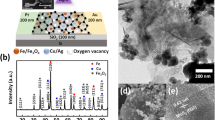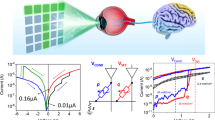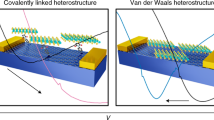Abstract
Combining the electronic properties of graphene1,2 and molybdenum disulphide (MoS2)3,4,5,6 in hybrid heterostructures offers the possibility to create devices with various functionalities. Electronic logic and memory devices have already been constructed from graphene–MoS2 hybrids7,8, but they do not make use of the photosensitivity of MoS2, which arises from its optical-range bandgap9. Here, we demonstrate that graphene-on-MoS2 binary heterostructures display remarkable dual optoelectronic functionality, including highly sensitive photodetection and gate-tunable persistent photoconductivity. The responsivity of the hybrids was found to be nearly 1 × 1010 A W−1 at 130 K and 5 × 108 A W−1 at room temperature, making them the most sensitive graphene-based photodetectors. When subjected to time-dependent photoillumination, the hybrids could also function as a rewritable optoelectronic switch or memory, where the persistent state shows almost no relaxation or decay within experimental timescales, indicating near-perfect charge retention. These effects can be quantitatively explained by gate-tunable charge exchange between the graphene and MoS2 layers, and may lead to new graphene-based optoelectronic devices that are naturally scalable for large-area applications at room temperature.
This is a preview of subscription content, access via your institution
Access options
Subscribe to this journal
Receive 12 print issues and online access
$259.00 per year
only $21.58 per issue
Buy this article
- Purchase on Springer Link
- Instant access to full article PDF
Prices may be subject to local taxes which are calculated during checkout




Similar content being viewed by others
References
Novoselov, K. S. et al. A roadmap for graphene. Nature 490, 192–200 (2012).
Dean, C. et al. Boron nitride substrates for high-quality graphene electronics. Nature Nanotech. 5, 722–726 (2010).
Radisavljevic, B., Radenovic, A., Brivio, J., Giacometti, V. & Kis, A. Single-layer MoS2 transistors. Nature Nanotech. 6, 147–150 (2011).
Ghatak, S., Pal, A. N. & Ghosh, A. Nature of electronic states in atomically thin MoS2 field-effect transistors. ACS Nano 5, 7707–7712 (2011).
Radisavljevic, B., Whitwick, M. B. & Kis, A. Integrated circuits and logic operations based on single-layer MoS2 . ACS Nano 5, 9934–9938 (2011).
Late, D. J., Liu, B., Matte, H. S. S. R., Dravid, V. P. & Rao, C. N. R. Hysteresis in single-layer MoS2 field effect transistors. ACS Nano 6, 5635–5641 (2012).
Bertolazzi, S., Krasnozhon, D. & Kis, A. Nonvolatile memory cells based on MoS2/graphene heterostructures. ACS Nano 7, 3246–3252 (2013).
Choi, M. S. et al. Controlled charge trapping by molybdenum disulphide and graphene in ultrathin heterostructured memory devices. Nature Commun. 4, 1624 (2013).
Mak, K. F., Lee, C., Hone, J., Shan, J. & Heinz, T. F. Atomically thin MoS2: a new direct-gap semiconductor. Phys. Rev. Lett. 105, 136805 (2010).
Xu, X., Gabor, N. M., Alden, J. S., van der Zande, A. M. & McEuen, P. L. Photo-thermoelectric effect at a graphene interface junction. Nano Lett. 10, 562–566 (2010).
Lemme, M. C. et al. Gate-activated photoresponse in a graphene p–n junction. Nano Lett. 11, 4134–4137 (2011).
Gabor, N. M. et al. Hot carrier-assisted intrinsic photoresponse in graphene. Science 334, 648–652 (2011).
Freitag, M., Low, T. & Avouris, P. Increased responsivity of suspended graphene photodetectors. Nano Lett. 13, 1644–1648 (2013).
Tielrooij, K. J. et al. Photoexcitation cascade and multiple hot-carrier generation in graphene. Nature Phys. 9, 248–252 (2013).
Biswas, C. et al. Negative and positive persistent photoconductance in graphene. Nano Lett. 11, 4682–4687 (2011).
Mueller, T., Xia, F. & Avouris, P. Graphene photodetectors for high-speed optical communications. Nature Photon. 4, 297–301 (2010).
Freitag, M., Low, T., Xia, F. & Avouris, P. Photoconductivity of biased graphene. Nature Photon. 7, 53–59 (2013).
Echtermeyer, T. et al. Strong plasmonic enhancement of photovoltage in graphene. Nature Commun. 2, 458 (2011).
Chitara, B., Panchakarla, L. S., Krupanidhi, S. B. & Rao, C. N. R. Infrared photodetectors based on reduced graphene oxide and graphene nanoribbons. Adv. Mater. 23, 5419–5424 (2011).
Ghosh, S., Sarker, B. K., Chunder, A., Zhai, L. & Khondaker, S. I. Position dependent photodetector from large area reduced graphene oxide thin films. Appl. Phys. Lett. 96, 163109 (2010).
Kastalsky, A. & Hwang, J. Study of persistent photoconductivity effect in n-type selectively doped AlGaAs/GaAs heterojunction. Solid State Commun. 51, 317–322 (1984).
Nathan, M. I. Persistent photoconductivity in AlGaAs/GaAs modulation doped layers and field effect transistors: a review. Solid State Electron. 29, 167–172 (1986).
Queisser, H. J. & Theodorou, D. E. Decay kinetics of persistent photoconductivity in semiconductors. Phys. Rev. B 33, 4027–4033 (1986).
Dawlaty, J. M. et al. Measurement of the optical absorption spectra of epitaxial graphene from terahertz to visible. Appl. Phys. Lett. 93, 131905 (2008).
Nair, R. R. et al. Fine structure constant defines visual transparency of graphene. Science 320, 1308 (2008).
Konstantatos, G. et al. Hybrid graphene–quantum dot phototransistors with ultrahigh gain. Nature Nanotech. 7, 363–368 (2012).
Kim, M., Safron, N. S., Huang, C., Arnold, M. S. & Gopalan, P. Light-driven reversible modulation of doping in graphene. Nano Lett. 12, 182–187 (2012).
Sachs, B. et al. Doping mechanisms in graphene–MoS2 hybrids. Preprint at http://arxiv.org/abs/1304.2236v1 (2013).
Britnell, L. et al. Strong light–matter interactions in heterostructures of atomically thin films. Science 340, 1311–1314 (2013).
Zomer, P. J., Dash, S. P., Tombros, N. & van Wees, B. J. A transfer technique for high mobility graphene devices on commercially available hexagonal boron nitride. Appl. Phys. Lett. 99, 232104 (2011).
Borghetti, J. et al. Optoelectronic switch and memory devices based on polymer-functionalized carbon nanotube transistors. Adv. Mater. 18, 2535–2540 (2006).
Star, A., Lu, Y., Bradley, K. & Grüner, G. Nanotube optoelectronic memory devices. Nano Lett. 4, 1587–1591 (2004).
Shi, Y. et al. Photoconductivity from carbon nanotube transistors activated by photosensitive polymers. J. Phys. Chem. C 112, 18201–18206 (2008).
Dutta, S. & Narayan, K. Gate-voltage control of optically-induced charges and memory effects in polymer field-effect transistors. Adv. Mater. 16, 2151–2155 (2004).
Acknowledgements
The authors acknowledge the Department of Science and Technology (DST) for a funded project under Nanomission. S.R. acknowledges support under grant no. SR/S2/CMP-02/2007 (DST).
Author information
Authors and Affiliations
Contributions
K.R. and A.G. conceived and designed the experiments. K.R. and M.P. performed the experiments. K.R., M.P. and A.G. analysed the data. S.G., T.P.S. and K.R. developed the heterostructure fabrication technique used in the experiment. G.R. and S.R. contributed CVD graphene material. K.R., M.P. and A.G. co-wrote the paper. All authors discussed the results and commented on the manuscript.
Corresponding authors
Ethics declarations
Competing interests
The authors declare no competing financial interests.
Supplementary information
Supplementary information
Supplementary Information (PDF 1389 kb)
Rights and permissions
About this article
Cite this article
Roy, K., Padmanabhan, M., Goswami, S. et al. Graphene–MoS2 hybrid structures for multifunctional photoresponsive memory devices. Nature Nanotech 8, 826–830 (2013). https://doi.org/10.1038/nnano.2013.206
Received:
Accepted:
Published:
Issue Date:
DOI: https://doi.org/10.1038/nnano.2013.206
This article is cited by
-
Miniaturized spectrometer with intrinsic long-term image memory
Nature Communications (2024)
-
Synergistic-potential engineering enables high-efficiency graphene photodetectors for near- to mid-infrared light
Nature Communications (2024)
-
Reconfigurable logic and in-sensor encryption operations in an asymmetrically tunable van der Waals heterostructure
Nano Research (2024)
-
Mixed-dimensional stacked nanocomposite structures for a specific wavelength-selectable ambipolar photoresponse
Nano Research (2024)
-
Neuro-inspired optical sensor array for high-accuracy static image recognition and dynamic trace extraction
Nature Communications (2023)



